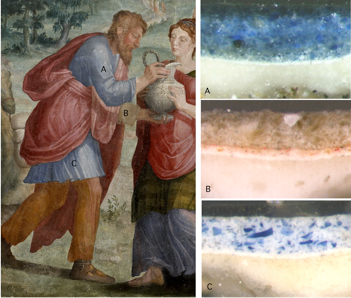Project

Transformation and degradation processes are generated by different factors. These can be internal to the work of art, like the nature of the constitutive materials and the techniques employed, or external, like environmental conditions, burial contexts, biological or human activity, as well as other circumstances of the object’s history. In order to plan an adequate restoration program and to prevent future damages, the transformation of materials must be understood. These transformations can be extremely complex, and it is by the application of complementary techniques that this kind of research can be successfully achieved.
We will present here some examples of degradation processes that could be adressed by this project. This research will be done in collaboration with conservators/restorators from different institutions (e.g. KIK-IRPA, museum and schools).
Easel paintings
Conservation problems can concern the interaction of materials from different layers.
- Deformation of the support (textiles, wood, …) is mainly associated to environmental conditions. Considering that paintings are composed sequence of superposed layers of different materials, with different physical properties. Differential deformation provokes the formation of cracks, and lack of adherence...Registering deformations by 3D imaging can be useful for the conservation diagnostics.
- Migration of elements in the layers leads to the deterioration of easel paintings. Production of lead soap and its migration to the surface.
- Discoloration of pigments, colorants and smalt cause confusion in the lecture of the paintings, as well as their aesthetic aspects. Study of these mechanisms, mostly caused by external chemical agents.
- Degradation of binding media and varnishes, and the distribution of the binding medium.
- Interaction of copper pigments with proteins and oil binding media and their influence on the colour of the paint layer.

Example of pigment degradation: smalt discoloration
Wall paintings
Research on conservation of wall paintings requires a global understanding of the building containing them. Their state of conservation depends mostly on the architecture and environmental factors. Therefore the study of wall paintings requires the analysis of the support (building materials of the wall), of the various mortars and coatings (cements, charges, and other additives), as well as the polychrome layer (pigments, dyes, and binders).
-Evaluation of porosity of the architectural materials (support, mortars and coatings), as well as the detection of the hollow zones are essential to plan an effective strategy of consolidation without constrain for the pictorial layer by 3D.
-The study of soluble salts that tend to migrate and re crystallize on the surface. This constitutes one of the most important factors of deterioration of the pictorial layer, translated into the lack of adhesion of the polychrome layer, fissures, and change of the perception of the colours.
-Study of consolidation products, and types of application, in order to evaluate the improvement of adhesion between layers, as well as penetration, and filling capacities.
-The degradation of the colour by the exposure to the light or the presence of micro-organisms.
-Colour changing of lead containing pigments and formation of brown lead (IV) oxide.
Manuscripts
-Study of the adherence to the support. The parchment is a peculiar flexible support. Its internal structure can endure really strong tensions. These phenomena can interfere with pictorial layer and some pigments like the copper blue pigment. The study of the adherence of the pictorial layer in the case of parchment, would be the first application of X-Ray microphotography applied to this material.
-Organic materials subject to oxidative stress (parchment, paper) due to the presence of inorganic pigmented materials (inks, paint) .
-Colour degradation in manuscripts is common, in spite of the poor exposure to light. Example: Illuminated manuscripts of the eleventh and the twelfth centuries present a blackening that occurs in the red area painted with cinnabar. This degradation has been observed and studied in easel paintings like the consequence of a modification of the cinnabar (HgS) into metacinnabar or, as suggested by the literature, a photosensitization by chloride ions in a humid environment, followed by degradation by the action of light. In the case of illuminated manuscripts it doesn’t seem to be the same chemical process. This phenomenon of degradation is always followed by a migration from metallic ions inside the parchment that could be studied.
-Colour changes in red and yellow lake pigments and dyes
Paper
-Scanning of ancient documents to define porosity and internal damages and correlate them with complimentary studies of the same object.
-The interaction between the pictorial layers, and inks with paper is greater than with the parchment. Analyses have to be done to understand the diffusion of pigments and inks inside the paper, as well as the acidity formed by the nature of the paper.
-The comparative analyses of paper constitutive materials (charges and additives), and of the inks with different state of conservation might be useful to understand their transformations, in order to develop new restoration treatments. Example: The metallic gall inks tend to corrode, and constitute an important problem of conservation. We would like to study the diffusion of the metallic ions inside the paper and to try to stabilize this diffusion.
Polychrome objects
The different supports of polychrome objects offer a wide range of transformation and degradation processes. Here we condense only some examples that can be studied by this multi-techniques protocol.
Ceramics
-The identification of salts, their migration and recrystallization. The evaluation of the porosity of ceramics, and of the adhesion between the layers of the various materials, and of the successive stages of firing. RBS spectrum can be used to evaluate the homogeneity of a layer and can be a very good mean to detect and understand a degradation process in particular in case of glass, glaze and enamels.
Painted glass
-Characterization of the products of corrosion of glass. Although glass is usually considered as a very stable archaeological material, it can undergo severe degradation. Soda-lime glass, the most common glass throughout ancient times, is particularly sensitive to this problem. The glass surface absorbs moisture from its environment and the contact with CO2 causes Na2O and NaOH to convert to Na2CO3 which is extremely hygroscopic. The subsequent unstable glass layer can be leached out and causes decomposition of the glass. The non-destructive PIGE–PIXE method of investigation allows detection of this phenomenon even if no visible effect appears.
Painted metals
-Degradation of paintings on metal, like copper, often concerns the formation of an oxidized layer between the support and the polychromy. On one hand, this provokes deformation of the support, and, therefore, loss of adhesion of the pictorial layer, and on the other, metallic particles migrate through the different layers reacting and damaging the constitutive materials.
-Study of corrosion/leaching on the surface and the evaluation of depth of this corrosion (3D).
Polychrome sculpture, vegetable fibres and textiles:
-Study of the supports deformations and porosity (3D), and later added materials. Measurement of penetration of resin for the consolidation of support.
-Identification of discoloured glaze layer, recognize the varnish and the yellow glaze layer on white metal leaf – imitation of gold leaf
-Evaluation of the degree of conservation of the underlying polychromy
- Discoloration and moisture stains. Lack of adhesion of the pictorial layer by deformation of the wood.
transformation and degradation


